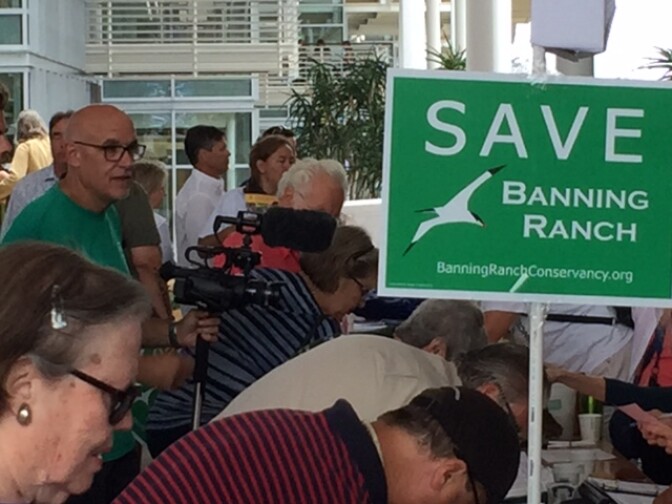This story is free to read because readers choose to support LAist. If you find value in independent local reporting, make a donation to power our newsroom today.
This archival content was originally written for and published on KPCC.org. Keep in mind that links and images may no longer work — and references may be outdated.
Coastal Commission denies controversial OC development
After a day of fierce lobbying from opposing sides, the California Coastal Commission late Wednesday night voted 9-1 to deny construction of the controversial Newport Banning Ranch development in Newport Beach. The project had sought to build nearly 900 homes, 45,000 square-feet of commercial space and a 75-room resort on one of the last stretches of undeveloped coastal land in Southern California.
The denial was greeted by cheers, laughter and tears of relief by about 100 opponents of the project who held on till the decision was finally made at 10:30 p.m., after a full day of deliberation and testimony.
"I'm so thrilled. I'm so excited," said Dorothy Kraus, vice president of Still Protecting Our Newport. "It has been such a long fight. For me, it's about the Coastal Act. They upheld the Coastal Act. It's amazing and wonderful."
Adam Alberti, project spokesman for the development group Newport Banning Ranch, had a different take.
"We are deeply disappointed in tonight's outcome," Alberti said. "We did all we could do to make this a viable project, and we couldn't make this work."
Earlier, the developers had warned the commission that they would sue if the panel had adopted a scaled-back version of the project that the commission's staff had favored. They said approving the smaller option would have constituted an illegal taking of private property.
But after the decision to reject the larger proposal, Alberti would not speculate on what the next step for the developers might be. They now have six months to submit any new proposal.
The 401-acre Banning Ranch site is a decades-old oil field punctuated by derricks and pocked with contamination.
The battle over it has been raging for two decades, and controversies over the firing of the commission's executive director earlier this year and several unreported meetings between commissioners and developers have prompted fear among environmentalists that the Coastal Commission had become pro-development.
The commission staff recently recommended approval of the project, but on a much smaller scale than developers wanted. The staff favored development on only 20 acres of the site compared to the roughly 60 acres the developers had called for.
At Wednesday's hearing on the plan, staff members warned the commissioners that the larger plan would violate the California Coastal Act.
Building a proposed road through the property is not permissible by the Coastal Act because it divides habitat and crosses buffer areas, staff members said. The other main violation of the Coastal Act, they said, is that developers needed to account for the foraging area of a species of owl that nests on the ground, not just the area where the bird nests.
"This is one of the most important decisions our commission has faced in four years, and I don't think that's hyperbole," said Jack Ainsworth, the commission's acting executive director.
Ainsworth has led the staff since Coastal Commissioners fired longtime executive director Charles Lester in March. Ainsworth urged the commissioners to follow the staff recommendation and approve the smaller project.
"We have based our recommendation on facts, sound science and the law," Ainsworth said. "And that's what we've done here. It's important to get it right here, because we can't go back."
The commissioners took a step beyond approving a smaller project, by dismissing the project altogether.
Commissioner Mary Shallenberger made the motion to deny, saying that the developer and staff were too far apart to agree on the project, so it made no sense to approve the scaled-down version.
"I ask for a no vote on this because the developer has made it clear they don't accept the staff report. They made it clear how far apart we are," Shallenberger said. "And this one we have to get right. This is the largest concentration of threatened and endangered species in all of Orange County. If we don't do it right, things will be lost forever."
The Coastal Commission met just a few miles from the Banning Ranch site in the Newport Beach City Council chambers, with a capacity of 150 people. That left hundreds of people spilling out the doors and around the building, sometimes craning their necks in the doorways to get a glimpse of the commission. A total of about 400 people filled out requests to comment.
The original plan for the land, approved by voters in the Newport Beach general plan in 2006, was to turn it into a park, and conservationists have long proposed buying the property for open space. After a general plan amendment, the Newport Beach City Council approved the Newport Banning Ranch developers' project in 2012.
"This is a very large scale plan to be approved by one submission," said Sherilyn Sarb, the staff deputy director. She said there are a number of outstanding issues and that the developer has not agreed with many requests and concerns raised by commission staff.
"There always been and still is a large difference of opinion with the developer," Sarb said. "We see there are big differences that remain."
The biggest difference, and the main change in the scaled-down staff recommendation, is more buffer area to protect wildlife, especially the burrowing owl.
"The staff report just goes too far," said Steven Kaufmann, lawyer for the developers, who said the additional buffer area is unnecessary. "It tries too hard and goes too far."









